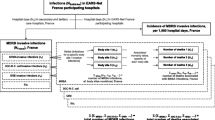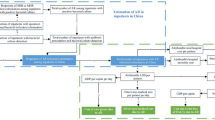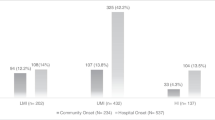Abstract
In 2009, the European Centre for Disease Prevention and Control (ECDC) estimated that multidrug-resistant (MDR) bacterial infections were responsible for 25,000 extra-deaths per year. In 2015, another report estimated that 12,500 extra-deaths were attributable to MDR bacteria every year in France. Recently, the United Nations claimed that resistance to antimicrobials was a global scourge, forecasting 10 million deaths in 2050. Surprisingly, our antibiotic resistance surveillance system in Marseille, France, did not allowed us to observe similar trends. We herein compared our data on extremely drug-resistant (XDR)/pandrug-resistant (PDR) patient extra-deaths to evaluations and predictions from these reports. First, we retrospectively collect and analyze antibiotic resistance data produced by our settings between November 2009 and March 2015 to look for 30-day deaths attributable to XDR/PDR strains belonging to 11 bacterial species/genus. In parallel, we performed a PubMed literature search to look for articles published prior to July 2016 and describing human deaths due to PDR strains. Overall, 35,723 patients were infected by at least one bacterial species/genus of interest and 85 by XDR/PDR strains. Of these patients, only one death was attributable to a XDR bacterial infection in a patient with strong comorbidities and two consecutive septic shocks. Our literature review shows that only four articles described human deaths due to PDR bacteria. All together, these data allowed us to conclude that there is a large discrepancy between the real count of deaths attributable to XDR/PDR bacteria and alarmist predictions.


Similar content being viewed by others
References
ECDC/EMEA Joint Technical Report (2009) The bacterial challenge: time to react. 2009. http://ecdc.europa.eu/en/publications/Publications/0909_TER_The_Bacterial_Challenge_Time_to_React.pdf. Accessed 17 May 2018
Bush K, Courvalin P, Dantas G, Davies J, Eisenstein B, Huovinen P et al (2011) Tackling antibiotic resistance. Nat Rev Microbiol 9:894–896
World Health Organization (2014) Antimicrobial resistance: global report on surveillance. http://apps.who.int/iris/bitstream/10665/112642/1/9789241564748_eng.pdf. Accessed 17 May 2018
Colomb-Cotinat M, Lacoste J, Coignard B, Vaux S (2015) Morbidité et mortalité des infections à bactéries multi-résistantes aux antibiotiques en France en 2012. http://invs.santepubliquefrance.fr/content/download/116892/409658/version/1/file/Rapport_DMI_RATB_Burden_BAT.pdf. Accessed 17 May 2018
O’Neill J (2014) Antimicrobial resistance: tackling a crisis for the health and wealth of nations. https://amr-review.org/sites/default/files/AMR Review Paper - Tackling a crisis for the health and wealth of nations_1.pdf. Accessed 17 May 2018
Abat C, Chaudet H, Colson P, Rolain J-M, Raoult D (2015) Real-time microbiology laboratory surveillance system to detect abnormal events and emerging infections, Marseille, France. Emerg Infect Dis 21:1302–1310
Dobbin C, Maley M, Harkness J, Benn R, Malouf M, Glanville A et al (2004) The impact of pan-resistant bacterial pathogens on survival after lung transplantation in cystic fibrosis: results from a single large referral centre. J Hosp Infect 56:277–282
Hadjiliadis D, Steele MP, Chaparro C, Singer LG, Waddell TK, Hutcheon MA et al (2007) Survival of lung transplant patients with cystic fibrosis harboring panresistant bacteria other than Burkholderia cepacia, compared with patients harboring sensitive bacteria. J Heart Lung Transplant 26:834–838
Falagas ME, Rafailidis PI, Matthaiou DK, Virtzili S, Nikita D, Michalopoulos A (2008) Pandrug-resistant Klebsiella pneumoniae, Pseudomonas aeruginosa and Acinetobacter baumannii infections: characteristics and outcome in a series of 28 patients. Int J Antimicrob Agents 32:450–454
Elemam A, Rahimian J, Mandell W (2009) Infection with panresistant Klebsiella pneumoniae: a report of 2 cases and a brief review of the literature. Clin Infect Dis 49:271–274
Rolain J-M, Abat C, Jimeno M-T, Fournier P-E, Raoult D (2016) Do we need new antibiotics? Clin Microbiol Infect 22:408–415
Ramírez-Estrada S, Borgatta B, Rello J (2016) Pseudomonas aeruginosa ventilator-associated pneumonia management. Infect Drug Resist 9:7–18
Bodey GP, Jadeja L, Elting L (1985) Pseudomonas bacteremia. Retrospective analysis of 410 episodes. Arch Intern Med 145:1621–1629
Recio R, Villa J, Viedma E, Ángeles Orellana M, Lora-Tamayo J, Chaves F (2018) Bacteraemia due to extensively drug-resistant Pseudomonas aeruginosa sequence type 235 high-risk clone: facing the perfect storm. Int J Antimicrob Agents In press https://doi.org/10.1016/j.ijantimicag.2018.03.018
ECDC. Antimicrobial resistance surveillance in Europe 2016 (2017) Annual Report of the European Antimicrobial Resistance Surveillance Network (EARS-Net). https://ecdc.europa.eu/sites/portal/files/documents/AMR-surveillance-Europe-2016.pdf. Accessed 17 May 2018
Abat C, Rolain J-M, Dubourg G, Fournier P-E, Chaudet H, Raoult D (2017) Evaluating the clinical burden and mortality attributable to antibiotic resistance: the disparity of empirical data and simple model estimations. Clin Infect Dis 65:S58–S63
de Kraker MEA, Stewardson AJ, Harbarth S (2016) Will 10 million people die a year due to antimicrobial resistance by 2050? PLoS Med 29(13):e1002184
Falagas ME, Tansarli GS, Karageorgopoulos DE, Vardakas KZ (2014) Deaths attributable to carbapenem-resistant Enterobacteriaceae infections. Emerg Infect Dis 20:1170–1175
Andersson DI, Hughes D (2010) Antibiotic resistance and its cost: is it possible to reverse resistance? Nat Rev Microbiol 8:260–271
Moran NA (2002) Microbial minimalism: genome reduction in bacterial pathogens. Cell 8(108):583–586
López-Rojas R, Domínguez-Herrera J, McConnell MJ, Docobo-Peréz F, Smani Y, Fernández-Reyes M et al (2011) Impaired virulence and in vivo fitness of colistin-resistant Acinetobacter baumannii. J Infect Dis 203:545–548
Hraiech S, Roch A, Lepidi H, Atieh T, Audoly G, Rolain J-M et al (2013) Impaired virulence and fitness of a colistin-resistant clinical isolate of Acinetobacter baumannii in a rat model of pneumonia. Antimicrob Agents Chemother 57:5120–5121
Levy Hara G, Kanj SS, Pagani L, Abbo L, Endimiani A, Wertheim HFL et al (2016) Ten key points for the appropriate use of antibiotics in hospitalised patients: a consensus from the Antimicrobial Stewardship and Resistance Working Groups of the International Society of Chemotherapy. Int J Antimicrob Agents 48:239–246
Pulcini C, Mainardi J-L (2014) Antimicrobial stewardship: an international emergency. Clin Microbiol Infect 20:947–948
Brouqui P, Jouve E, Romain F, Sambuc R, Raoult D (2014) Are infectious disease doctors better at caring for infectious diseases than other specialists? Clin Infect Dis 58:1486–1487
Brouqui P, Boudjema S, Soto Aladro A, Chabrière E, Florea O, Nguyen H et al (2017) New approaches to prevent healthcare-associated infection. Clin Infect Dis 65:S50–S54
Lagier J-C, Aubry C, Delord M, Michelet P, Tissot-Dupont H, Million M et al (2017) From expert protocols to standardized management of infectious diseases. Clin Infect Dis 65:S12–S19
Lagier JC, Million M, Fournier PE, Brouqui P, Raoult D (2015) Faecal microbiota transplantation for stool decolonization of OXA-48 carbapenemase-producing Klebsiella pneumoniae. J Hosp Infect 90:173–174
Brouqui P, Aubry C, Million M, Drancourt M, Raoult D (2013) Totally resistant tuberculosis: will antileprosy drugs be helpful? Int J Antimicrob Agents 42:584–585
Pulcini C, Mohrs S, Beovic B, Gyssens I, Theuretzbacher U, Cars O et al (2017) Forgotten antibiotics: a follow-up inventory study in Europe, the USA, Canada and Australia. Int J Antimicrob Agents 49:98–101
Dubourg G, Okdah L, Le Page S, Rolain J-M, Raoult D (2015) In vitro activity of “old antibiotics” against highly resistant Gram-negative bacteria. Int J Antimicrob Agents 46:718–720
Abat C, Raoult D, Rolain J-M (2018) Are we living in an antibiotic resistance nightmare? Clin Microbiol Infect XXX:1–2
McGann P, Snesrud E, Maybank R, Corey B, Ong AC, Clifford R et al (2016) Escherichia coli harboring mcr-1 and blaCTX-M on a novel IncF plasmid: first report of mcr-1 in the United States. Antimicrob Agents Chemother 60:4420–4421
Magiorakos AP, Srinivasan A, Carey RB, Carmeli Y, Falagas ME, Giske CG et al (2012) Multidrug-resistant, extensively drug-resistant and pandrug-resistant bacteria: an international expert proposal for interim standard definitions for acquired resistance. Clin Microbiol Infect 18:268–281
Author information
Authors and Affiliations
Corresponding authors
Ethics declarations
Conflict of interest
The authors declare that they have no conflict of interest.
Ethical approval
For this type of study formal consent is not required.
Informed consent
Not applicable.
Rights and permissions
About this article
Cite this article
Abat, C., Fournier, PE., Jimeno, MT. et al. Extremely and pandrug-resistant bacteria extra-deaths: myth or reality?. Eur J Clin Microbiol Infect Dis 37, 1687–1697 (2018). https://doi.org/10.1007/s10096-018-3300-0
Received:
Accepted:
Published:
Issue Date:
DOI: https://doi.org/10.1007/s10096-018-3300-0




